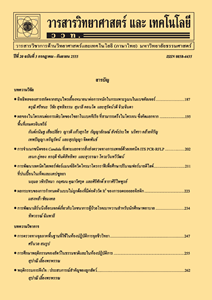Preparation and Application of Dried Almond Residue for Substitution of Almond Flour in Macaron
Main Article Content
Abstract
The objective of this research was to study the preparation of dried almond residue from the production of almond milk, for almond flour substitution in macaron. The almond residue was dried using a tray dryer at 60, 70 and 80 ºC, until the residue has the moisture content at 3-5 %, followed by 100 % substitution of almond flour in the macaron production. The results showed that the drying times were 360, 210 and 180 minutes, respectively. The optimal drying condition of dried almond residue preparation was 80 ºC drying temperature for 180 minutes, which was the most of total dietary fiber and insoluble fiber and the shortest time. The dried almond residue had the values of L*, b*, fat and protein contents, lower than those of almond flour. However, the carbohydrate level and total dietary fiber were significantly higher than those of almond flour (p ≤ 0.05). The almond flour was substituted with 100 % dried almond residue in the macaron formula. The macaron with dried almond residue at 80 ºC temperature for 180 minutes, had the values of L*, a*, b*, aw, hardness (N) and crispiness (mm) as 82.80, 6.26, 6.50, 0.82, 434.66, and 0.62, respectively. Sensory scores of aroma, taste, texture and overall preference of macaron with dried almond residue were not different from those of the control formula (p > 0.05). The overall liking score was “like slightly” and improvement of total dietary was 278% (from 0.88 to 2.45 gram per piece)
Article Details
References
Hiruntrakool, T.P. and Thiengnoi, T., 2007, The best of walnuts and almond in the world, Kehakaset 31(11): 198-203. (in Thai)
Bennett, B.L., 2016 Almond Flour: The High-protein, Gluten-free Choice for Bake and Cooking, Book Publishing Company, Summertown, 160 p.
Richardson, D.P., Astrup, A., Cocaul, A. and Ellis, R.P., 2009, The nutritional and health benefits of almonds: A healthy food choice, Food Sci. Technol. Bull. Funct. Foods 6: 41-50.
Bolling, B.W., Chen, C.Y., McKay, D.L. and Blumberg, J.B., 2011, Tree nut phytochemicals: Composition, antioxidant capacity, bioactivity, impact factors – A systematic review of almonds, Brazils, cashews, hazelnuts, macadamias, pecans, pine nuts, pistachios and walnuts, Nutri. Res. Rev. 24: 244-275.
Yada, S., Lapsley, K. and Huang, G.W., 2011, A review of composition studies of cultivated almonds: Macronutrients and micronutrients, J. Food Compos. Anal. 24: 469-480.
USDA, 2015, National Nutrient Database for Standard Reference Release 28, Available Source: https://ndb.nal.usda.gov/ndb/foods/show/3635?manu=&fgcd=&ds=, December 17, 2016.
Garrido, I., Monagas, M., Gómez-Cordovés, C. and Bartolomé, B., 2008, Polyphenols and antioxidant properties of almond skins: Influence of industrial processing, Food Sci. 73: C106-C115.
Maréchal, J., 2010, Secrets of Macaroon, Murdoch books Australia, New South Wales, 140 p.
Bunyasawat, J. and Bhoosem, J., 2013, Supplementation of Fiber in Macaron Product with Sangyod Rice Bran, Research for Home Economics Technology, Rajamangala University of Technology Phra Nakhon, Bangkok, 75 p. (in Thai)
Panyayong, C. and Khantasen, V., 2018, Development of almond powder substitute macaron from cashew nut powder, J. Sci. Technol. Srinakharinwirot Univ. 10(19): 14-30.
AOAC, 2016, Offcial Methods of Analysis of AOAC International, 20th Ed., AOAC International, Gaithersburg.
Dusit Thani College, 2018, Macaron Recipe, Dusit Thani College, Bangkok.
Rangsadthong, W., 2014, Food Processing Technology, 6th Ed., Text and Journal Publication Co., Ltd., Bangkok, 477p. (in Thai)
Rattanapanone, N., 2014, Food Chemistry, 5th Ed., Odeon Store Publisher, Bangkok, 504 p. (in Thai)
Hengsawad, D., 2002, Dietary fiber for health, Food J. 32: 157-159. (in Thai)
Mandalari, G., Tomaino, A., Arcoraci, T., Martorana, M., Lo Turco, V., Cacciola, F., Rich, G.T., Bisignano, C., Saija, A., Dugo, P., Cross, K.L., Parker, M.L., Waldron, K.W. and Wickham, M.S.J., 2010, Characterization of polyphenols, lipids and dietary fiber from almond skins (Amygdalus communis L.), Food Compos. Anal. 23: 166-174.
Mandalari, G., Faulks, R.M., Rich, G.T., Lo Turco, V., Picout, D.R., Lo Curto, R.B., Bisignano, G., Dugo, P., Dugo, G., Waldron, K.W., Ellis, P.R. and Wickham, M.S.J., 2008, Release of protein, lipid, and vitamin E from almond seeds during digestion, Agric. Food Chem. 56: 3409-3416.
Chulakarangka, S., 2010, Nutrition, 6th Ed., Kasetsart University Publisher, Bangkok, 314 p. (in Thai)
Hongsprabhas, P., 2012, Colloidal systems in food products, Kasetsart University Publisher, Bangkok, 296 p. (in Thai)
Beaudoin, S.S., 2014, Macaron by chef Gio, Amarin Printing & Publishing, Bangkok, 106 p. (in Thai)
Kong, X., Li, H., Wang., H, Hua, Y. and Huang, Y. 2008, Effect of lipoxygenase activity in defatted soybean flour on the gelling properties of soybean protein isolate, Food Chem. 106: 1093-1099.


